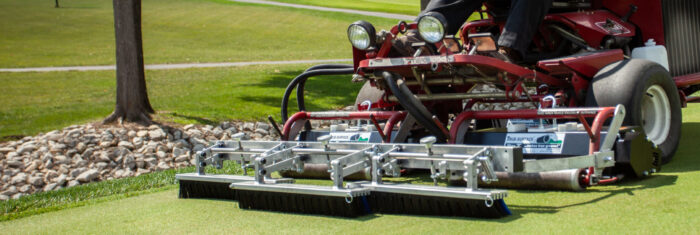Brushing three to four days a week during peak growing season will not hurt your greens. Actually, it will only enhance your putting surface. Brushing promotes healthier upright greens that can compete with poa annua on a day-in and day-out basis.
Denser, more upright bentgrass stand
If you start brushing during the growing season, in two weeks the coarse-texture horizontal leaf blades will be gone. Plus, the remaining tissue will have a finer texture that’s vertically oriented. After three to four weeks, the plants will respond by making new plants between the existing plants. The result is increased density and finer texture. Your greens will become firmer and faster—all without extra work.
 Denser, more upright bentgrass stand
Denser, more upright bentgrass stand
Some superintendents have found that by brushing weekly, they can raise their mowing height to a healthier position and still achieve the ball speed and smoothness they desire. Superintendents who brush regularly have also reported less disease pressure, firmer and faster greens, improved recovery from ball marks, and healthier stand of creeping bentgrass.
Which brush to use?
I suggest starting with a brush that fits your budget and your needs. Brushes or mats attached to a mower or bucket are the most efficient for labor—after all, who wants to add extra labor? If you can’t afford it, try coco mats or pull-behind drag brushes to test the water. If using out-front brushes, I suggest a medium to stiff brush in the early spring and fall, and then move into a soft brush to better handle the summer stress.
 Transformer brushes
Transformer brushes
When do I start brushing?
Wait to start brushing until ground temperatures reach 60°F (15°C) and use this as your reference point in the fall. During a prolonged drought and the heat-stressed times of mid- to late-summer, do not brush more than once or twice a week.
The results?
If done correctly, you’ll find that brushing will give you the same desired results as vertical mowing, but with less stress and damage to the plant itself. How’s that for a win-win?




